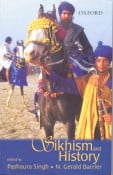In-Depth Coverage of Issues Concerning the Global Sikh Community Including Self-Determination, Democracy, Human Rights, Civil Liberties, Antiracism, Religion, and South Asian Geopolitics

| He alone is a Sikh, a friend, a relative and a sibling, who walks in the way of the guru's will. One who walks according to his own will, suffers separation from the Lord, and shall be punished (Guru Amardas, AG, p. 601). |